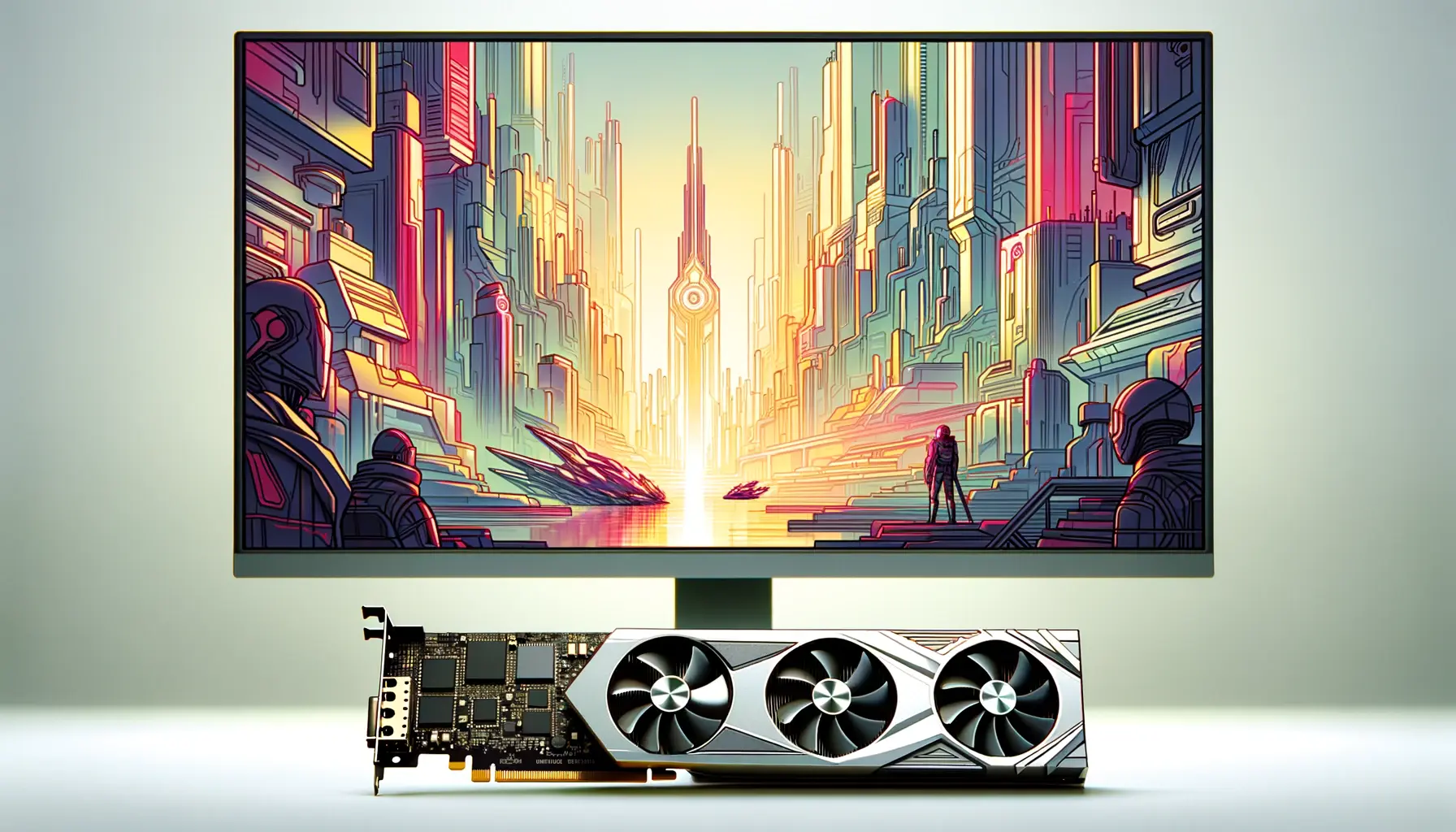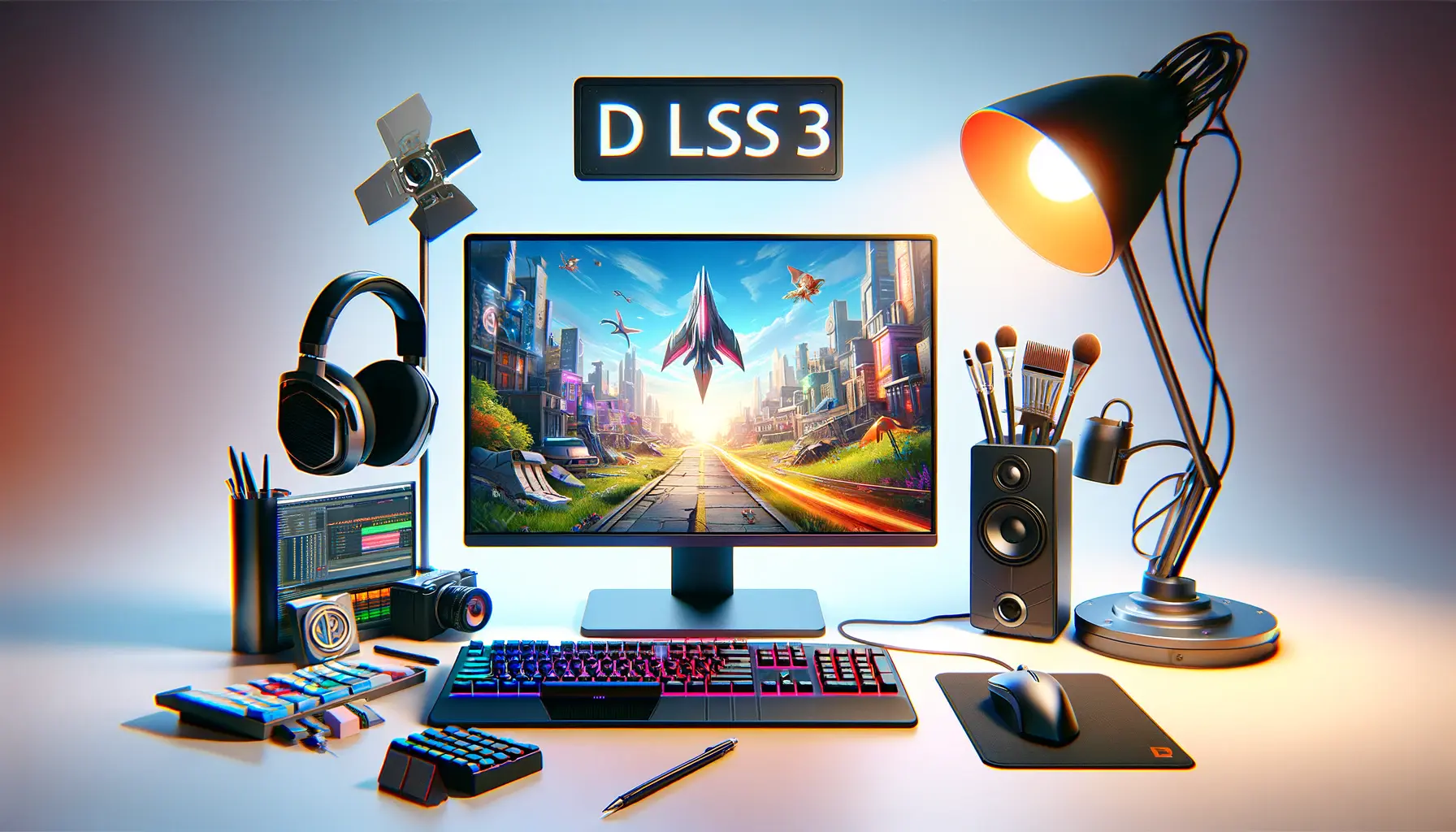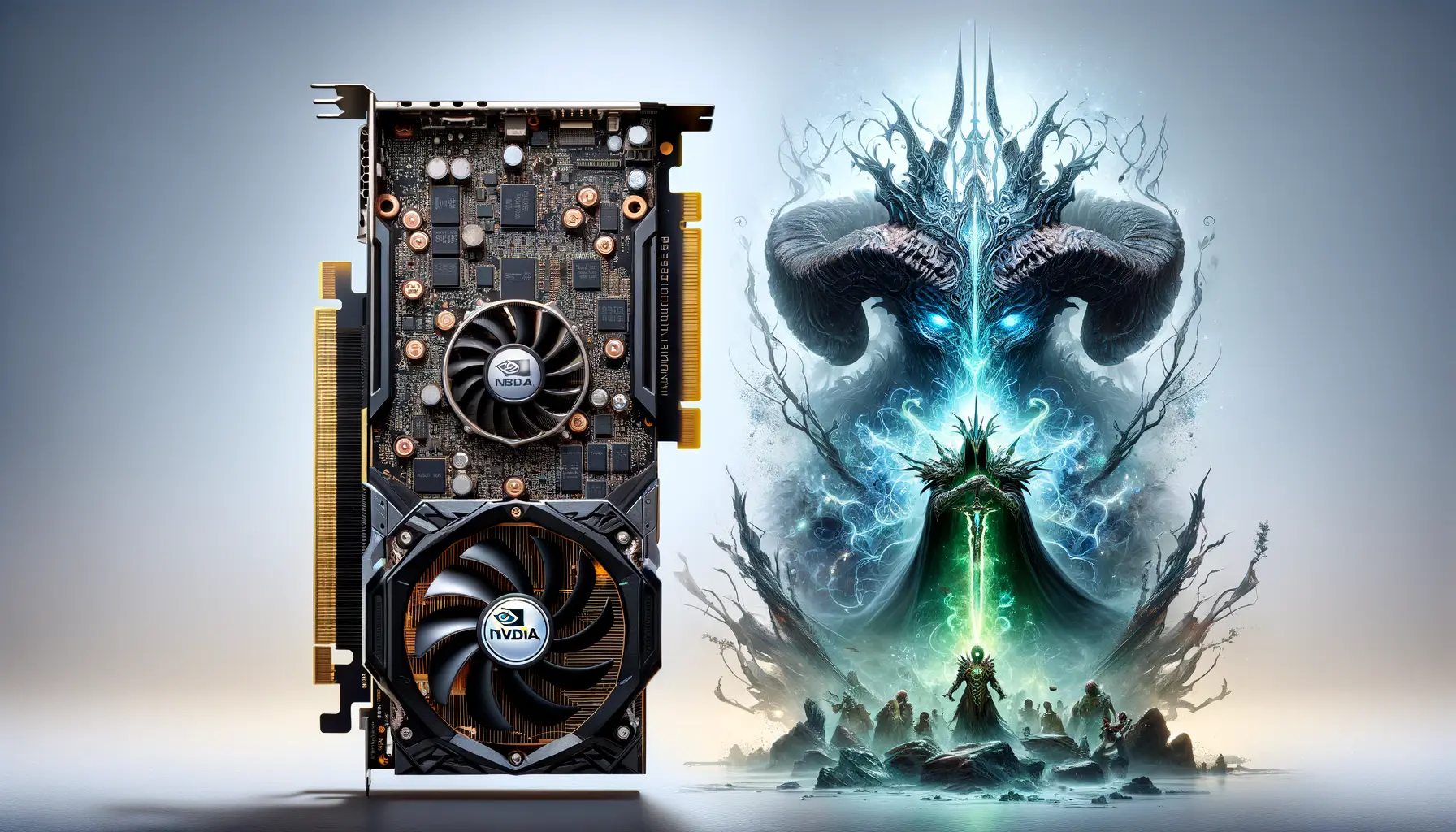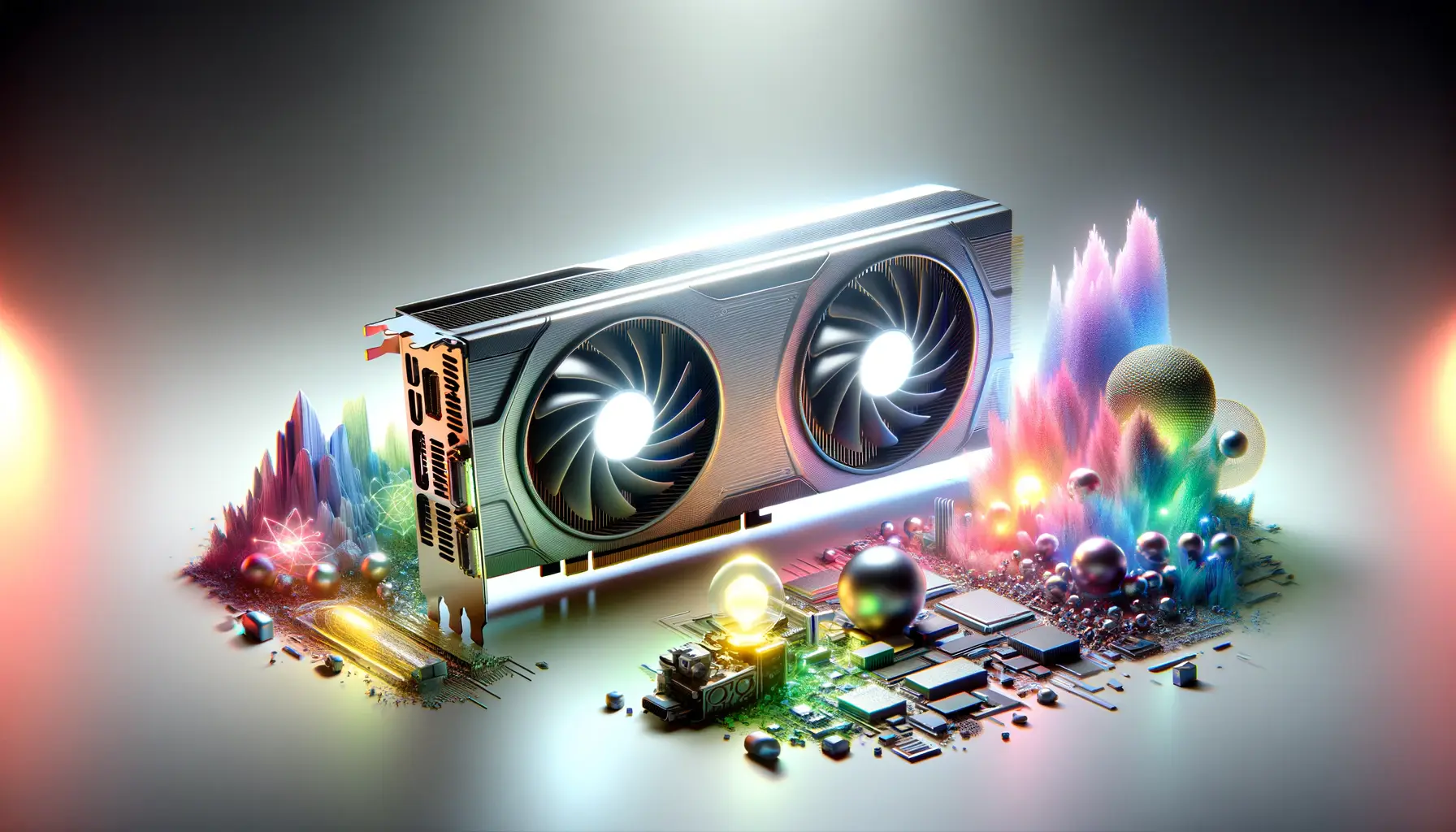The integration of Deep Learning Super Sampling (DLSS) 3 into game development marks a significant leap towards achieving ultra-realistic graphics and seamless gameplay experiences.
NVIDIA’s DLSS 3, the latest iteration in the series, harnesses the power of artificial intelligence to upscale images in real-time, delivering higher frame rates without compromising on visual quality.
This technology is not just an enhancement; it’s a revolution that redefines what games look like and how they are played.
At the core of DLSS 3’s integration into game development is its ability to provide a solution to the ever-present challenge of balancing performance with high-quality graphics.
With the gaming industry’s rapid advancement, developers constantly seek ways to push the boundaries of realism and immersion.
DLSS 3 emerges as a pivotal tool in this quest, offering a way to elevate game visuals to unprecedented levels while ensuring smooth performance across a wide range of hardware.
- Understanding DLSS 3 and Its Impact on Gaming
- The Integration Process of DLSS 3 in Game Development
- Benefits of DLSS 3 for Gamers and Developers
- DLSS 3’s Role in Achieving Photorealism in Games
- Optimizing Game Performance with DLSS 3
- DLSS 3 and the Future of Game Development
- Exploring the Challenges and Solutions in DLSS 3 Integration
- Embracing the Future with DLSS 3 Integration
- DLSS 3 Integration in Game Development FAQs
Understanding DLSS 3 and Its Impact on Gaming
Deep Learning Super Sampling, or DLSS, is a groundbreaking technology developed by NVIDIA that utilizes neural networks to analyze and upscale lower-resolution images in real-time.
By rendering fewer pixels and then using AI to intelligently upscale the image, DLSS 3 allows games to run at higher frame rates without sacrificing the quality of the graphics.
This is particularly beneficial for gamers who do not have the latest high-end hardware but still desire a high-quality gaming experience.
DLSS 3’s integration into game development is not just about enhancing visual fidelity; it’s also about reimagining game design possibilities.
Developers can now create more detailed and complex game environments, knowing that DLSS 3 will help maintain a smooth gameplay experience.
This technology also opens up new avenues for creativity, enabling designers to implement high-quality graphical features that were previously too performance-intensive for real-time rendering.
Key Components of DLSS 3
The magic behind DLSS 3’s performance lies in its key components: the AI-powered algorithms and the dedicated Tensor Cores found in NVIDIA’s RTX series GPUs.
These algorithms are trained on a vast dataset of high-quality, game-like images, allowing the AI to learn how to produce similar high-quality upscaling results.
The Tensor Cores, specialized hardware designed to accelerate AI computations, ensure that this upscaling process is incredibly efficient, enabling real-time performance even in the most graphically demanding games.
Another significant aspect of DLSS 3 is its adaptability.
The technology is designed to work across a variety of games and genres, from fast-paced shooters to expansive open-world titles.
This versatility makes DLSS 3 an invaluable tool for developers looking to optimize their games for a broad audience.
By integrating DLSS 3, developers can ensure that their games are accessible to players with different hardware capabilities, thus widening their potential market.
DLSS 3 represents a harmonious blend of AI and gaming technology, pushing the envelope of what’s possible in game development and offering a glimpse into the future of immersive gaming experiences.
The Integration Process of DLSS 3 in Game Development
Integrating DLSS 3 into game development is a process that involves several key steps, ensuring that games not only look better but also run more smoothly on a wide range of hardware.
This integration process is crucial for developers aiming to leverage DLSS 3’s full potential to enhance their games’ visual fidelity and performance.
The process begins with the developers incorporating the DLSS SDK into their game engines.
NVIDIA provides comprehensive support and documentation to facilitate this integration, making DLSS 3 accessible to a broad spectrum of game developers, from indie creators to large studios.
Steps for Integrating DLSS 3
- Acquiring the DLSS SDK: Developers must first download the DLSS SDK from NVIDIA’s developer portal. This SDK contains all necessary libraries and documentation to get started with DLSS integration.
- Engine Integration: The next step involves integrating the DLSS libraries into the game’s rendering pipeline. This requires some modifications to the game engine to ensure it can correctly utilize DLSS features.
- Testing and Optimization: Once DLSS is integrated, developers need to thoroughly test their games to fine-tune the DLSS settings. This involves adjusting the balance between performance and image quality to suit the game’s specific needs.
- Feedback Loop: NVIDIA encourages developers to provide feedback on their experience with integrating DLSS. This feedback is crucial for NVIDIA to continue improving DLSS technology and support.
Challenges and Solutions
While integrating DLSS 3 offers numerous benefits, developers may encounter challenges along the way.
One common challenge is ensuring that the upscaling process does not introduce unwanted artifacts or blur in the game’s visuals.
To address this, NVIDIA continuously updates the DLSS SDK with improvements and new features based on developer feedback and advancements in AI research.
Another challenge is optimizing DLSS for different types of games.
A fast-paced shooter may have different performance and quality requirements compared to a slow-paced strategy game.
NVIDIA’s DLSS SDK offers various settings and modes to help developers customize the DLSS behavior to fit their game’s unique characteristics.
The integration of DLSS 3 into game development not only enhances the gaming experience for players but also serves as a testament to the power of AI in pushing the boundaries of technology and creativity in the gaming industry.
Benefits of DLSS 3 for Gamers and Developers
The adoption of DLSS 3 technology in game development brings a multitude of benefits, not just for the gamers who enjoy enhanced visual experiences but also for the developers who strive to create these immersive worlds.
Understanding these benefits is crucial for appreciating the impact of DLSS 3 on the gaming industry as a whole.
For Gamers
- Improved Frame Rates: One of the most immediate benefits gamers notice is the significant improvement in frame rates. DLSS 3 allows games to run smoother, making fast-paced action more responsive and enjoyable.
- Enhanced Visual Quality: DLSS 3’s AI-driven upscaling ensures that gamers can enjoy higher resolutions without needing top-tier hardware, bringing ultra-high-definition gaming to a broader audience.
- Reduced Hardware Requirements: By offloading some of the rendering workload to AI, DLSS 3 reduces the need for cutting-edge hardware, making high-quality gaming more accessible.
For Developers
- Broader Audience Reach: By lowering the hardware requirements for high-quality gaming, developers can reach a wider audience, including gamers with mid-range systems.
- Enhanced Creative Freedom: The performance gains from DLSS 3 allow developers to push the boundaries of game design, incorporating more detailed textures, complex lighting effects, and expansive game worlds without worrying about performance bottlenecks.
- Optimization Tools: NVIDIA provides developers with tools and analytics to optimize the implementation of DLSS 3, ensuring the best balance between performance and visual fidelity.
Case Studies: Real-World Examples
Several high-profile games have successfully integrated DLSS 3, showcasing its benefits.
For instance, a popular open-world game reported a 2x increase in frame rates at 4K resolution, significantly enhancing the gameplay experience without degrading visual quality.
Another example is a competitive shooter that achieved smoother frame rates on mid-range hardware, making the game more competitive and enjoyable for a larger player base.
These case studies demonstrate DLSS 3’s transformative potential in game development.
By enabling higher frame rates and better visuals across a wide range of hardware, DLSS 3 is setting a new standard for what games can achieve.
DLSS 3 is revolutionizing the gaming experience, offering a glimpse into the future of interactive entertainment where visual fidelity and performance are no longer mutually exclusive.
DLSS 3’s Role in Achieving Photorealism in Games
The quest for photorealism in video games has been an ongoing journey for developers and artists alike.
With the advent of DLSS 3, the industry is now closer than ever to achieving this goal.
DLSS 3 not only enhances performance but also plays a pivotal role in rendering lifelike graphics that blur the line between virtual and reality.
Enhancing Visual Details
DLSS 3’s AI-driven approach to upscaling allows for the rendering of games at lower resolutions, which are then intelligently upscaled to higher resolutions without losing detail.
This means that textures, lighting, and shadows can be rendered with a level of detail previously unattainable in real-time gameplay.
For gamers, this translates to environments and characters that look incredibly real and immersive.
Moreover, the efficiency of DLSS 3 enables developers to incorporate advanced graphical features such as ray tracing, which simulates real-world lighting, reflections, and shadows with remarkable accuracy.
The combination of DLSS 3 and ray tracing is a game-changer, offering a level of realism that was once only possible in pre-rendered scenes.
Overcoming Performance Challenges
One of the biggest hurdles to achieving photorealism in games is the performance impact of high-fidelity graphics.
Higher detail levels typically require more processing power, which can lead to lower frame rates and a less enjoyable gaming experience.
DLSS 3 addresses this challenge head-on by providing a way to maintain high performance while pushing the boundaries of visual quality.
By leveraging the power of AI to upscale images, DLSS 3 allows games to run at higher frame rates even when rendering complex scenes.
This means that developers no longer have to choose between stunning visuals and smooth performance; with DLSS 3, they can have both.
Future Implications
The implications of DLSS 3 for the future of game development are profound.
As this technology continues to evolve, we can expect to see even more realistic games that offer immersive experiences indistinguishable from reality.
DLSS 3 is not just improving games today; it’s shaping the future of how games are made and experienced.
For developers, DLSS 3 opens up new possibilities for creative expression, allowing them to craft worlds and stories with unprecedented detail and realism.
For gamers, it means stepping into these worlds and experiencing them in a way that was once only imaginable.
The journey towards photorealism in games is accelerating, and DLSS 3 is leading the charge.
DLSS 3 is a cornerstone technology in the pursuit of photorealism in games, enabling developers to create more detailed and immersive worlds without compromising on performance.
Optimizing Game Performance with DLSS 3
DLSS 3 is not just a tool for enhancing visual fidelity; it’s also a powerful solution for optimizing game performance.
By intelligently upscaling images, DLSS 3 allows games to run at higher frame rates on a wide range of hardware, from high-end gaming rigs to more modest setups.
This section delves into how developers can leverage DLSS 3 to fine-tune their games for optimal performance.
Performance Tuning Strategies
- Dynamic Resolution Scaling: Developers can implement dynamic resolution scaling alongside DLSS 3 to adjust the game’s rendering resolution in real-time based on performance metrics. This ensures that the game maintains a smooth frame rate during demanding scenes.
- Adjustable Quality Settings: Offering adjustable quality settings for DLSS within the game allows players to choose the right balance between image quality and performance based on their preferences and hardware capabilities.
- Profiling and Benchmarking: Utilizing NVIDIA’s profiling tools, developers can analyze the performance impact of different DLSS settings and game features, enabling them to make informed optimizations.
Case Studies: Performance Gains
Several developers have shared their experiences with integrating DLSS 3, highlighting significant performance improvements.
For example, a graphically intensive RPG saw a 70% increase in frame rates at 4K resolution with DLSS 3 enabled, without compromising on the game’s stunning visual detail.
Another case involved a competitive multiplayer shooter, where DLSS 3 helped maintain a consistent 144+ FPS on mid-range GPUs, ensuring a competitive and smooth gameplay experience.
These case studies underscore DLSS 3’s role in enabling developers to achieve both their artistic vision and performance goals, providing gamers with the best possible experience.
Best Practices for Developers
- Early Integration: Integrating DLSS 3 early in the development process allows for more time to test and optimize the game’s performance across different hardware configurations.
- Continuous Testing: Regularly testing the game on a variety of hardware ensures that DLSS 3 optimizations are effective for a wide audience, from gamers with older GPUs to those with the latest hardware.
- Feedback Loop: Encouraging feedback from the gaming community on performance and visual quality can provide valuable insights for further optimizations.
Optimizing game performance with DLSS 3 is a dynamic process that involves balancing visual fidelity with smooth gameplay, ensuring that all players can enjoy the best possible experience regardless of their hardware.
DLSS 3 and the Future of Game Development
The integration of DLSS 3 into game development is not just a current trend but a glimpse into the future of gaming.
As technology evolves, DLSS 3 sets a precedent for how AI and machine learning can significantly enhance the gaming experience.
This section explores the potential future developments in game technology inspired by DLSS 3 and its impact on the industry.
Advancements in AI Technology
DLSS 3 is at the forefront of leveraging AI for gaming, and its success paves the way for further advancements in AI-driven game development.
Future iterations of DLSS could offer even more sophisticated upscaling techniques, reducing the computational load on GPUs while delivering even higher-quality visuals.
As AI models become more efficient and capable, we can expect to see real-time rendering of games at resolutions and detail levels that are unimaginable today.
Moreover, AI technology could extend beyond graphics, enhancing other aspects of game development such as AI-driven game design, dynamic storytelling, and NPC behavior, making games more immersive and responsive to player actions.
Broader Hardware Accessibility
- Expanding to More Platforms: While DLSS 3 currently requires NVIDIA’s RTX series GPUs, future developments could see similar technology becoming available on a wider range of hardware, including consoles and mobile devices, broadening the accessibility of high-quality gaming experiences.
- Cloud Gaming: DLSS 3 could play a significant role in cloud gaming, allowing for high-quality game streaming over less-than-ideal internet connections by reducing the bandwidth needed for high-resolution gaming.
Impact on Game Design
The capabilities of DLSS 3 and future AI technologies will undoubtedly influence game design.
Developers will have more freedom to create complex and detailed game worlds without being constrained by hardware limitations.
This could lead to a new era of game design where the focus shifts from optimizing for performance to pushing the boundaries of creativity and immersion.
Additionally, the democratization of high-quality gaming through DLSS 3 and similar technologies could inspire a new generation of game developers, making game development more accessible to indie developers and small studios.
The future of game development, shaped by DLSS 3 and subsequent AI advancements, promises an era of unprecedented realism, accessibility, and creativity in gaming, transforming how we create and experience games.
Exploring the Challenges and Solutions in DLSS 3 Integration
While DLSS 3 offers a plethora of benefits for game development, integrating this advanced technology into games is not without its challenges.
Developers face various hurdles, from technical implementation to ensuring compatibility across different hardware.
However, with every challenge comes a solution, and the gaming industry’s collaborative spirit ensures that DLSS 3 continues to evolve and improve.
Technical Implementation Hurdles
One of the primary challenges in integrating DLSS 3 is the technical complexity involved.
Ensuring that the AI-driven upscaling seamlessly works with a game’s existing rendering pipeline can require significant adjustments and optimizations.
Developers must become familiar with the DLSS SDK and how it interacts with their game engines, which can be a steep learning curve for some.
Solutions to these technical challenges include comprehensive documentation, developer forums, and direct support from NVIDIA.
By leveraging these resources, developers can navigate the complexities of DLSS 3 integration more effectively, ensuring that their games can take full advantage of this technology.
Ensuring Compatibility Across Hardware
Another challenge is ensuring that games utilizing DLSS 3 run smoothly across a wide range of hardware configurations.
While DLSS 3 is designed to boost performance and visual quality, differences in GPU capabilities can lead to varying experiences among players.
To address this, developers can implement dynamic scaling options and customizable DLSS settings within their games, allowing players to fine-tune their gaming experience based on their hardware’s capabilities.
Regular updates and optimizations based on player feedback also play a crucial role in maintaining compatibility and performance across different systems.
Keeping Up with Rapid Technological Advancements
The fast pace of technological advancements in the gaming industry means that developers must continually update and refine their implementation of DLSS 3 to keep up with new GPU models and features.
This requires a commitment to ongoing learning and adaptation.
Engaging with the broader developer community and participating in NVIDIA’s developer programs can help studios stay informed about the latest developments in DLSS technology.
Collaborating with other developers and sharing knowledge and best practices can mitigate the challenges posed by rapid technological advancements.
Despite the challenges, the benefits of integrating DLSS 3—ranging from enhanced visual fidelity to improved game performance—far outweigh the hurdles, making it a worthwhile endeavor for game developers aiming to push the boundaries of what’s possible in gaming.
Embracing the Future with DLSS 3 Integration
The journey through the realms of DLSS 3 integration in game development unveils a landscape where technology and creativity converge to redefine the gaming experience.
As we’ve explored the multifaceted benefits, challenges, and the profound impact DLSS 3 has on both developers and gamers, it’s clear that this technology is not just a fleeting trend but a cornerstone for the future of gaming.
The Road Ahead for Game Development
DLSS 3 stands at the forefront of a revolution, pushing the boundaries of what’s possible in digital entertainment.
Its role in achieving photorealism, optimizing performance, and shaping the future of game design underscores its significance in the industry.
As developers continue to harness the power of DLSS 3, we can anticipate a new era of games that are more immersive, accessible, and visually stunning than ever before.
Key Takeaways for Developers and Gamers
- DLSS 3’s AI-driven approach to upscaling and performance optimization offers a glimpse into the future of gaming, where experiences are defined by unparalleled visual fidelity and fluid gameplay.
- The integration of DLSS 3 allows developers to expand their creative horizons, crafting detailed and expansive game worlds without the constraints of hardware limitations.
- For gamers, DLSS 3 means enjoying high-end gaming experiences on a wider range of hardware, making the latest titles more accessible to a broader audience.
Final Thoughts on DLSS 3 Integration
As we stand on the brink of new advancements in gaming technology, DLSS 3 integration represents a pivotal moment in game development.
It embodies the harmonious blend of artificial intelligence and creative vision, setting a new standard for what games can achieve.
The journey of integrating DLSS 3 is one of exploration, innovation, and collaboration, leading us toward a future where the lines between reality and virtual worlds blur in the most beautiful ways.
In conclusion, the integration of DLSS 3 in game development is not just about enhancing graphics or improving frame rates; it’s about opening up new possibilities for storytelling, art, and human connection through the medium of video games.
As we look forward to the future, it’s clear that DLSS 3 will play a crucial role in shaping the next generation of gaming, making now an exciting time to be part of this ever-evolving industry.
DLSS 3 Integration in Game Development FAQs
Explore commonly asked questions about DLSS 3 and its integration into game development, providing insights into how this technology enhances gaming experiences.
DLSS 3 uses AI to upscale images, improving frame rates and visual quality without needing high-end hardware, making games smoother and more detailed.
Developers integrate DLSS 3 by incorporating NVIDIA’s SDK into their game engines, adjusting their rendering pipelines for compatibility.
DLSS 3 is designed for NVIDIA’s RTX series GPUs, leveraging their Tensor Cores for AI-driven upscaling and performance improvements.
Yes, DLSS 3 can significantly enhance game performance on older hardware by reducing the graphical load while maintaining visual quality.
Challenges include mastering the technical complexity of DLSS 3 integration and ensuring compatibility across a range of hardware configurations.
DLSS 3 allows for more detailed and expansive game worlds by improving performance, giving developers greater creative freedom.
All game genres benefit from DLSS 3, but visually intensive games like open-world titles and shooters see the most significant improvements.
Future advancements may include more efficient AI models for upscaling, broader hardware support, and integration into cloud gaming platforms.













